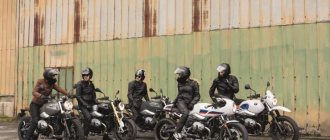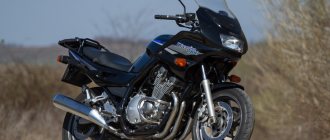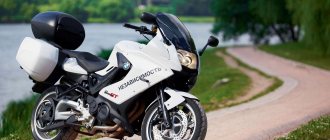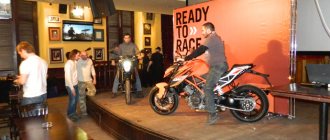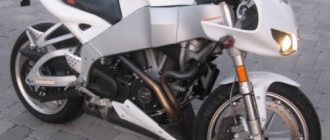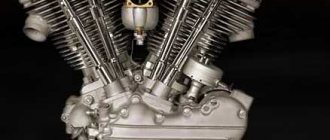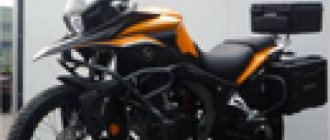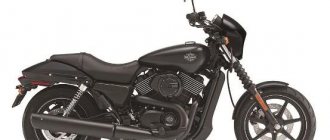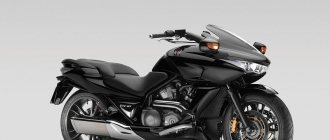In-line 4- and 6-cylinder engines have brought great success to BMW's Bavarian motorcycle engine factories, but the tried and true Boxer Twin remains the brand's key engine design. BMW continues to develop the Boxer line. And now the company has expanded it with the release of the new R1200RS.
First ride on the 2016 BMW R1200RS
BMW's R-series of sports motorcycles have a long history of their own. The R1200RS appeared back in the 70s. The old model was then replaced in the Boxer line-up by the R1200S in 2007. Also representatives of the line were the HP2 Sport and S1000RR.
Now the BMW R1200RS is back along with the much improved R1200R. Both bikes feature a liquid-cooled Boxer engine (the last bike not to feature liquid cooling was the R nineT, since the company began installing the system on motorcycles, starting with the 2013 R1200GS). The Twin engine with a volume of 1170 cubic centimeters produces a maximum power of 125 hp. and 124.73 Nm of torque. On RS and R models, bottom-end torque is improved thanks to a modified airbox and exhaust. As for the new radiator placement, it ties in with another significant change to this model, which is the replacement of the traditional Telelever suspension with an inverted 43mm fork.
The BMW R1200RS is a more or less enhanced version of the R model. Additional changes include, for example, a two-position adjustable windshield. The solid tubular handlebar design has also been replaced with a new two-piece aluminum design. BMW has increased the wheelbase of the motorcycle by 2.54 cm and now it is 152.4 cm. Also, the seat height of the BMW R1200RS motorcycle at 81.28 cm is 2.54 cm higher than the seat height of the R model (78.74 cm). The R1200RS also weighs 5.44kg more than the R. The bike has a claimed dry weight of 235.86kg.
Ride the BMW R1200RS
I tested the new R1200RS the day after my test drive of the updated 2015 S1000XR. The first day I tested the XR it rained all day. But the next day, when I set out to ride the R1200RS, the weather was excellent and I took my route through beautiful countryside, 2 expressways and several city roads.
The liquid-cooled Boxer may be a little different from previous air-oil-cooled versions, but it's still an attractive powerplant. I've driven the entire BMW Boxer line (except the R nineT) and would like to point out that the R1200RS engine didn't give me any trouble. Its twin-cylinder engine has a decent and consistent mid-range. This bike is certainly not the 160bhp beast of the S1000XR I rode the day before my ride on the bike, but the RS doesn't need to be. The Boxer's engine has more than enough performance for spirited driving. He works very well.
In the basic configuration of the BMW R1200RS, two driving modes are available, “Rain” and “Road”, as well as ABS and the automatic stabilization system ASC (“Automatic Stability Control”).
Rain mode softens throttle response and tunes ASC to low-grip and wet road conditions. For an additional cost, you can install the “Ride Modes Pro” option, which will add 2 more riding modes, Dynamic and User, as well as dynamic traction control (DTC). The DTC system works in conjunction with the tilt angle sensor.
The Dynamic ride mode gives sharper throttle response and makes DTC intervention less intrusive (to improve electronic control in the Rain and Road ride modes, the DTC complements them with its two corresponding settings - "Wet" and "Dry").
A driver-adjustable User mode allows the rider to combine throttle response and DTC settings based on their personal preferences.
On road
Unfortunately, the bike I tested didn't have Ride Modes Pro or DTC, so I can't speak to their effectiveness. However, my R1200RS had a few extra features, such as Gear Shift Assist Pro, also found on last year's RT model, which helps shift gears without using the clutch. Smooth downshifting requires the throttle to be fully closed. When it comes to upshifting, shifting into second and third is not as flawless as shifting the rest of the gears of the 6-speed transmission. The RS's Gear Shift Assist Pro system felt a bit lackluster compared to the smoother shifting on the BMW S1000XR (perhaps just the bikes I tested). Gear Shift Assist Pro is a nice addition, but not necessary as the bike's clutch works quite well. I liked the RS's wide powerband. I passed difficult sections of the road in 3rd gear, for example long turns. And in high gears I drove on highways.
The new motorcycle has also been equipped with Electronic Suspension Adjustment (ESA). ESA automatically adjusts suspension damping, both front and rear, based on real-time readings. ESA has two modes - “Road” and “Dynamic”. ESA also offers push-button rear shock preload adjustment, with 3 settings (single rider, rider with luggage and rider with pillion).
On the road in “Dynamic” mode the suspension dampens very well. When switching from “Road” to “Dynamic” mode, nothing terrible happens, only the motorcycle’s suspension becomes a little stiffer in order to better match the sporty riding pace. On bikes with Ride Modes Pro and DTC installed, ESA works in conjunction with the lean angle sensor, which is something I'm keen to test in the future.
More noticeable than the ESA intervention is that the 2021 R1200RS uses a conventional fork. Over the years I have come to appreciate the special handling characteristics of motorcycles equipped with Telelever suspension, with a few exceptions (notably the K1300S). The advantage of the Telelever is the stability of the braking and the fact that there is no feeling of the front end sinking, but at the same time there is some loss of road feel, which requires the rider to have complete trust in the suspension and its settings. The new R1200RS suspension requires no such blind faith and gives the driver excellent road feel. Also, electronic control of the suspension provides the same benefits as the Telelever suspension, such as good brake feel and minimal “dive” of the front of the motorcycle.
The BMW R1200RS doesn't corner as easily as a supersport or superbike, but it doesn't turn unwieldy. And when the bike leans into corners, there is good stability. I really liked the feeling of stability when riding the RS. Regardless of the speed, the motorcycle always has good grip.
At the front, 4-piston Brembo calipers squeeze two 320 mm discs, while at the rear, a 276 mm disc is held in place by a 2-piston caliper. The brakes have great stopping power. True, the braking stability mentioned above, which motorcycles with Telelever suspension possess, is somewhat reduced on the R1200RS, but not very much. The motorcycle leaves the factory with a built-in ABS system from BMW. The driver can turn off ABS (as well as ASC). The RS's ABS works well, but I have to admit that I liked the ABS Pro system better on the S1000XR I tested the day before I test-drove the RS. This system, also found on the HP4 and S1000RR, works based on lean angle and other important metrics.
The R1200RS's riding position is a good mix of sport and touring positions. You can sit upright on the motorcycle, but you can also adopt a more aggressive forward leaning position if you wish. The placement of the controls is correct and comfortable, but the footpegs are positioned a little differently than I expected, although on this bike they are placed in a way that I found roomier than on the R. I liked the cozy RS seat, which is comfortable to ride all day. Its height is 82 cm and it did not seem too high to me (my height is 185 cm). In addition, the standard seat can be replaced with a lower one with a height of 76 cm, or a higher one with a height of 84 cm.
Hello Bikepost! I suddenly realized that I forgot to publish a review of the test BMW R1200RS. I'm correcting myself! Well, for those who like to read, please cut!
The BMW R1200RS is one of the few modern representatives of the gradually dying out class of two-cylinder sports-touring motorcycles with an engine capacity of a liter and above. Let's remember such previously popular devices as the Honda VTR1000F or Suzuki TL1000S and SV1000. Where are they now? That's right, they remained on the pages of encyclopedias and sales sites in the used equipment section.
Why is this type of motorcycle gradually disappearing? Firstly, because they are usually very compromising - and not exactly tourists, but at the same time they are as interested in sportbikes as they are in the moon. And secondly, because every company that produced such motorcycle models did it according to the principle “it will do.” The engineers, apparently not even the most outstanding ones, are given the task “build an inexpensive touring bike for all occasions.” They rack their brains for a long time, but in the end they can’t come up with anything better than going to the warehouse and assembling a new motorcycle from the parts that the company already has in its arsenal. Oh, this sportbike has a cool two-cylinder engine, let's take it! Only, of course, we will deforce at the same time! Oh, and the frame suits us, let's take it. Only the geometry, of course, needs to be corrected. Reiki, trails, that's all. Let's put a simpler suspension, this is a motorcycle for all occasions! And why bother with the brakes, the engine is derated. Clients, of course, sooner or later begin to understand this and little by little interest in such motorcycles subsides.
Of course, the R1200RS is not 100% compliant with these standards. Its engine, for example, is not from a sportbike and is not derated, but from the “water goose” R1200GS, accordingly, it initially has a more friendly character. And the brakes are excellent; fortunately, since the late 90s, BMW has forgotten how to save on such critical things. But otherwise, the RS's compromise is still visible everywhere. And this is perhaps my biggest complaint.
Well, what kind of sportbike is this? By sports standards, the RS is plump, weighing 236 kilograms when loaded. And stunted - only 125 horses per two hundred liter. Up to a hundred in 3.3 seconds! Impressive? Well, only on paper. In fact, with such a power supply, even any modern sports six hundred will beat it!
Maybe he's more of a tourist? Wind protection is excellent, especially if the glass is set to the top position. Heated grips, cruise control, soft seat, central case, mount for a navigator, clip-ons... Wait, what, clip-ons on a touring motorcycle?! Yeah, and the pilot's position is slightly tilted forward. Of course, if you do not take into account the clip-ons, non-optimal fit and vibrations traditional for BMW boxer cars, in other respects the R1200RS leaves only pleasant impressions in everyday use. I rode it last fall, but did not freeze, did not get wet, and did not experience any problems at all. The clutch is light and the handling is excellent. After all, the R1200RS inherited the frame and suspension from the R1200R roadster. True, the RS has a shorter fork offset than the R1200R, so it should steer a little faster than the Roadster. Unfortunately, I cannot confirm this fact, because I have not driven the roadster itself. For those who like to ride, the R1200RS has one more advantage - you can use a proprietary quickshifter. It works perfectly smoothly if you really turn the engine to high speeds and brake strongly with a quick downshift. True, on this motorcycle it was possible to do without such a purely racing option. It’s just a shame that the boxer gearbox turned out to be not as clear and delicate as the classic air-cooled one, I’m talking about the R nineT. The R1200RS again requires little gasoline - only 5.4 liters per hundred. In the summer, I would probably drive faster and the consumption would be a little higher.
I also had one funny situation on the R1200RS, which almost turned into an epic fail. My girlfriend and I were driving along Prospekt Mira one morning. More precisely, we were crawling, because as always there was an impassable traffic jam in front of the Severyaninsky Bridge. And then another box taxis in front of me, deciding to change lanes from right to left, I slow down a little harder until it comes to a complete stop, the passenger slides down the seat, leaning on me with his 50 kilograms... It would seem like a normal situation, right? Fuck it! The passenger moves me forward a little on the seat, because it is quite slippery, if you are wearing leather gear, I put my legs out and-and-and-and... And I cling to the edge of the cylinder protection with the top strap of the left motorcycle boot! Realizing that in another second, we will be lying together with the motorcycle on our left side, in horror, with a sharp jerk, I pull my leg up and literally instantly place it on the asphalt. It passed, but, of course, I built a brick factory because I was not ready for such a joke.
The R1200RS is a good bike, but its problem is that BMW's lineup is full of even better touring bikes. Compared to them, the RS looks like a black sheep. And, as you remember, there is also a very cool superbike and comparing the RS with it is simply pointless. The only really significant advantage of the R1200RS against their background is its super-adequate price tag of 1,040,000 rubles. XR is 162,000 more expensive, and RT is almost 300,000 more expensive! And this is the cost of the whole G310R! I’m generally silent about the price tag of “GiTikhi”.
In general, this device is not for everyone to stand out in traffic. Well, for connoisseurs of German quality, because in general the R1200RS is reliable and unpretentious. Several of my foreign acquaintances use such motorcycles and none of them have had problems with them.
Touring motorcycle
If we consider this motorcycle as a touring motorcycle, then in this regard it has intriguing capabilities. The fairing, which is actually a semi-fairing, confirms this. BMW has given the motorcycle excellent aerodynamics, for example, the unobtrusive deflectors bordering the fairing and tank are quite effective. They are somewhat reminiscent of the small plastic air vents on the R1200GS Adventure, which add to the comfort level of the ride. The RS windshield provides excellent protection against oncoming air flows. I liked its simple two-position adjustment. You can also install heated grips for an additional fee.
But on particularly long journeys, the RT's cocoon-like fairing and massive electronically controlled windshield would still be of better help. But additional elements of the travel kit will add 38 kg of weight. Therein lies the big question about the new R1200RS: what role will it play in the Boxer range?
BMW's tagline for the R1200RS is "the power of a sport bike and the comfort of a touring bike" and I think that's a fair assessment of the bike. The sport-tourer motorcycle segment is moving toward heavy-duty, more option-packed platforms. And BMW has its own RT model, which is a prime example of this trend. If I were asked to rate the RT as a “sport-touring”, my rating would look like this - 20% - sport, 80% - tourist, but with the RS everything is completely different.
The 17.79 liter tank makes the R1200RS feel more like a sportsbike than a touring bike (the RT's 25 liter fuel tank, for example). With the same fuel efficiency as the R model of 17 kilometers per liter, the RS is claimed to be with a fully filled tank it will cover 322 km. But, it seems to me that the driver will have to refuel every 240-260 km.
But riders can rest assured that they will be well informed about fuel levels and a host of other indicators by reading them on the R1200RS instrument panel. On the left is an analogue speedometer, next to which is a TFT display. The display is easy to read and displays a wealth of essential information such as gear changes, timing, as well as Ride Mode and ESA settings. And on the RS display, which is also available on the R model, you can choose from three styles of displaying information. This is a very original feature. You may think that this is all too confusing and not much is needed... So many options, buttons and all that... Well.. If we talk about the importance and necessity of some options, then on the RS you can also purchase the Keyless Ride option for an additional cost, which, I thought it should allow you to start the motorcycle without a key, but in order to start the motorcycle you still need to turn the key. Therefore, I, as a simple person, cannot appreciate the advantages of such systems and for some reason their meaning and importance are not at all clear to me.
Some people may not like the styling of the BMW R1200RS, but I liked its lines, especially the blue-gray color scheme that the bike I rode had. The build quality and finish of the motorcycle is luxurious. The most inexpensive configuration of this motorcycle is the Standard Package. The more expensive package is called the Premium Package. The number of options varies depending on the configuration. For an additional cost, you can also purchase the Style 2 Package, which has beautiful changes to the appearance of the motorcycle such as gold painted calipers, a stainless steel tank cover, an engine spoiler, and a gray frame.
Riding the BMW R1200RS for a full day showed that I could really enjoy riding it. It's the kind of bike that will probably go unnoticed by most riders, but I suspect the sizeable contingent of Boxer fans eagerly awaiting the new R1200RS won't be disappointed. The RS joins the versatile R-Series lineup as a legitimate, great touring bike.
MY MOTORCYCLE
Opposite - when I hear this word, pictures of our Soviet cassons, Dnieper, Urals, or the glorious BMW company, which produces (and will continue to produce) motorcycles with this type of engine to this day, immediately pop up. Bavarian bikes with this power unit have thoroughly occupied the niche of touring motorcycles and many cannot create tough competition for them.
But the real legend will forever remain the Bavarian two-cylinder boxer engine with almost a century of history, thanks to which a huge number of motorcycles were born, both in Germany and in other countries. By the way, the Soviet “Ural” and “Dnepr” were also initially equipped with this German power unit, although later the designers started producing copies of the engine.
BMW presented in Cologne (back in 2014) a rather interesting sports tourer for active driving. For those who have been and continue to be fans of “boxer” engines: the BMW R1200RS is a “dressed up” HP2, only with all the goodies and an awesome design. Honestly, the Germans surprise me again. They manage to keep up with the times with the seemingly “outdated boxer engine type” and also create cool, advanced bikes.
The new product is a sports-touring bike, the platform for which, according to some experts, was the naked BMW S1000R, although the designers had to replace its four-cylinder in-line engine with a two-cylinder boxer. The new BMW R 1200 RS combines these credentials with both sharp performance and sporty, dynamic design. The aerodynamic styling of the two-position wind deflector with two headlights forms the attractive face of the new BMW R 1200 RS. Dynamic proportions give the motorcycle sporting prowess and the ability to ride comfortably on the road. The two colors and style finishes highlight the powerful character of the new R 1200 RS in their own individual way.
The wheelbase of the BMW R1200RS was increased by approximately 12 mm to 1529 mm, and the seat was installed a couple of centimeters higher than that of the S1000R. Also, the sports-tourer BMW R1200RS significantly surpassed its predecessor in weight - the curb weight of the new product is 236 kilograms, which is six kg more than that of a naked car.
The power unit of the BMW R1200RS motorcycle has the same 125 horses and 125 Newton meters of torque at 6500 rpm - but thanks to the new airbox and exhaust system, the engine has become more torquey at the bottom. Compared to the engines in the GS, GS Adventure and RT, torque has actually been increased slightly at low revs. Exhaust gases are routed through a 2-into-1 exhaust system with a rear muffler that is sharply angled for a dynamic effect. Also, instead of two radiators, one is placed centrally. In addition, the signature Telelever suspension at the front of the BMW R1200RS has been replaced with an inverted 45mm fork.
The BMW R1200RS motorcycle has been crammed with electronics beyond belief. And it’s so modern and interesting that it’s breathtaking: two, already standard, driving modes “Rain” and “Road”, and in general - Road, Rain, Road Pro and DTC. The first two are installed along with the basic equipment package, the rest are available optionally for an additional fee. Road Pro mode allows the rider to independently make adjustments to the operation of the engine and a number of motorcycle systems, while DTC, also known as Dynamic Traction Control, provides the rider with the maximum possible protection and even care, virtually controlling his every movement. The system takes into account the condition of the road surface, determines whether the surface on which the motorcycle is moving is slippery, constantly monitors the speed of rotation of the front and rear wheels, and in case of deviation from the specified parameters, immediately cuts off the fuel supply to the engine combustion chambers. With such bells and whistles, the motorcycle can compete with modern new cars.
Another electronic feature of the BMW R1200RS is Gear Shift Assist Pro, a system that can change gears without having to press the clutch lever. When this function is activated, downshifts occur as smoothly as possible, almost imperceptibly for the driver. In order to reset one gear, it is enough to completely remove the gas. Upshifts are more noticeable, especially in second and third gears. However, in general, many call Gear Shift Assist Pro not a very popular, although pleasant, option, because the clutch of the BMW R1200RS performs its functions more than adequately, the torquey engine pulls well in the first three gears, and the next three are usually in demand only at high speed. country highway.
Electronic suspension control or ESA (DynamicElectronicSuspensionAdjustment) turned out to be much more useful. This system can independently set the preload and rebound settings of the front and rear shock absorbers depending on the quality of the road surface. ESA has two operating modes - a soft Road, which is suitable for long trips, and a harder Dynamic, which is more suitable for sports driving or high-speed rides. ESA also allows you to adjust the motorcycle's suspension before riding for one or two passengers and luggage.
Overall, the ride on the BMW R1200RS leaves only the most pleasant sensations - the gears shift very smoothly, and the brakes, when needed, prove their reliability every time. By the way, compared to the naked, the sports-touring modification is equipped with more powerful brakes - two 320 mm discs at the front and one 276 mm disc at the rear, which are in the arms of reliable four- and two-piston Brembo machines. They can stop the motorcycle literally on the fly.
But with all this, the new product is more suitable for a quiet country trip than dizzying dashes around the city or racing on a sports track.
BMW R1200RS, technical specifications
BMW R1200RS 2021 Specifications:
Engine: Boxer Twin Engine Displacement: 1170 cubic centimeters Bore x stroke length: 101 x 73 mm Compression ratio: 12.5:1 Transmission: 6-speed gearbox Clutch: Multi-plate in an oil bath, working on par with the Gear Shift Assist system Front suspension : 45mm inverted fork, -139.7mm travel. Electronic suspension adjustment system ESA. Rear suspension: pendulum Paralever, WAD, with a stroke of 139.7 mm. Preload adjustment. Electronic suspension adjustment system ESA. Front brake: Two 320 mm discs with 4-piston Brembo calipers Rear brake: One 276 mm disc with 2-piston caliper ABS: Integrated BMW ABS, can be switched off Tires: 120/70 ZR 17, 180/55 ZR 17 Curb weight: 236 kg Wheelbase: 1529 mm Seat height: standard - 82 cm, optional low seat - 76 cm and sports seat - 84 cm Fuel tank capacity: 17.79 l
Additional options R1200RS:
• Ride Modes Pro • ESA Electronic Suspension Control • Trip Computer Pro (Touring Package only) • Cruise Control • Gear Shift Assist Pro • GPS • Rack • Saddle Bags • Chrome Exhaust • Heated Grips • Tire Pressure Monitor TPM • Keyless Ride Option
Standard Package:
• GPS • Chrome exhaust • Heated grips • Cruise control • Saddle bags
Premium Package (includes Comfort Package and Touring Package)
• Keyless Ride option • Gear Shift Assist Pro system
Comfort Package:
• Chrome Exhaust • Heated Grips • TPM Tire Pressure Monitoring System
